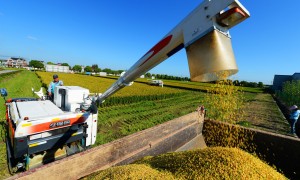说到外骨骼,你或许觉得很陌生,但如果提到钢铁侠的战甲,你一定非常熟悉。事实上,这种“战甲”正被越来越多地应用到我们的现实生活中,也许有一天,你也能成为钢铁侠!

Imagine wearing high-tech body armour that makes you super strong and tireless. such technology, more specifically called an exoskeleton, sounds like the preserve of the Iron Man series of superhero movies.
想象自己穿上高科技人体铠甲,变得超级强大、不知疲倦。这种技术的学名为外骨骼,听起来就像超级英雄电影《钢铁侠》系列的保留项目。
Yet the equipment is increasingly being worn in real life around the world. And one manufacturer - California's SuitX - expects it to go mainstream.
在现实生活中,全球各地使用这种铠甲的人越来越多。美国加州的外骨骼制造商SuitX公司期待这种产品会成为主流。
"There is no doubt in my mind that these devices will eventually be sold at hardware stores," says SuitX's founder Homayoon Kazerooni.
SuitX公司的创始人霍马永·卡泽鲁尼说:“我认为这种设备最终必然会在五金店销售。”
In simple terms, an exoskeleton is an external device that supports, covers and protects its user, giving greater levels of strength and endurance.
简而言之,外骨骼就是支撑、遮盖和保护使用者的外部设备,为其提供更高水平的力量和耐力。
Sometimes also referred to as "wearable robots", they can be battery-powered and computer-operated, incorporating motors and hydraulics. Or they can be more simple, passive designs that use springs and dampeners.
外骨骼有时也被称为“可穿戴机器人”,有的靠电池供电、电脑操作,包含发动机和液压装置,也有比较简单的运用弹簧和减震器的被动式设计。
"Integrating humans and machines into one system opens up a new realm of opportunity," says Adrian Spragg, an expert on the technology at management consultancy Accenture. "Many of the early applications have been focused on military and medical applications, but in the last several years there's been an explosion of use in a range of cases."
管理咨询公司埃森哲的外骨骼技术专家阿德里安·斯普拉格说:“将人类和机器融为一体打开了一个充满机遇的新领域。许多早期应用主要集中在军事和医疗领域,但是过去几年,多个领域的使用量剧增。”
This expansion, which has come together with rapid advances in the technology, has seen exoskeletons increasingly used by manufacturing workers. Versions for consumers are also now being developed to help people more easily do everything from DIY, to walking, climbing stairs, and other daily activities.
与此同时,伴随着技术的快速发展,制造工人越来越多地使用外骨骼。厂商现在也研发出了消费者版外骨骼,来帮助人们更容易地从事DIY(自己动手做)、走路、爬楼梯和其他日常活动。
One report says sales are now due to rocket as a result. Global exoskeleton revenues are expected to rise from $392m in 2020 to $6.8bn in 2030, according to a study by ABI Research.
一份报告称,外骨骼的销量会因此飙升。互联网数据资讯网的调查指出,全球外骨骼收入有望从2020年的3.92亿美元(约合人民币25.7亿元)增至2030年的68亿美元(约合人民币446亿元)。
SuitX's "suits" are now being tested by car manufacturers General Motors and Fiat. Prof Kazerooni, who is also the director of the University of California's Berkeley Robotics and Human Engineering Laboratory, says that the primary benefit of the firm's exoskeletons is to prevent muscle fatigue.
SuitX的“铁甲”目前正在接受汽车制造商通用公司和菲亚特公司的测试。加州大学伯克利分校机器人与人体工程实验室的主任卡泽鲁尼表示,该公司外骨骼产品的主要功用就是防止肌肉疲劳。
"We've shown that muscle activity in the back, shoulder and knees drops by 50%," he says. "If muscle activities drop, that means the risk of muscle injury is less.
他说:“我们的产品展示出背部、肩膀和膝盖的肌肉活动减少了50%。如果肌肉活动减少,意味着肌肉损伤风险也降低了。”
"This means that factory or plant managers get more productivity, their insurance costs are lower, and there are less workdays lost to injury. There's less cost and more productivity."
“这意味着工厂或工厂经理可以获得更高生产效率,保险费用支出更低,因工伤而损失的工时也会减少。成本降低了,生产效率却提高了。”
General Motors is also looking at a battery-powered exoskeleton glove developed by Bioservo.
通用汽车公司同时也在测试Bioservo公司研发的一款靠电池供电的外骨骼手套。
This glove, called the Iron Hand, has sensors and motors in each finger, which automatically respond to the level of force that the wearer applies to his or her hand when lifting or gripping something. The glove therefore takes up some of the strain.
这种被称作“铁掌”的手套每个手指处都有传感器和发动机,可以自动应对用户在抬或抓东西时使出的不同水平的力度,从而可以分担一部分压力。
BioServo says it can increase the wearer's hand strength by 20% for extended periods.
Bioservo表示,这款手套可以在一段较长的时间内将佩戴者的手劲增加20%。
The most advanced exoskeletons use artificial intelligence (AI) computer systems - software that can to a certain extent learn and adapt by itself.
最先进的外骨骼产品使用人工智能电脑系统,智能软件可以让外骨骼在某种程度上自主学习和适应。
At the moment, however, more widespread adoption of exoskeleton technology is still held back by a number of factors, including battery capacity, limited range of motion, and cost.
然而,目前外骨骼技术的进一步广泛应用受到了多种因素的阻碍,包括电池容量、活动度有限和成本。
"The average cost [of a full-body exoskeleton] is around $45,000," says Accenture's Mr Spragg. "However, with economies of scale and technological maturity, prices will come down."
埃森哲的斯普拉格指出:“一副全身外骨骼大约需要4.5万美元。但是,随着经济规模的扩大和技术的成熟,价格会降下来。”
SuitX's Prof Kazerooni says that falling prices will also open up the possibility to tap into a potentially huge market - recreational exoskeletons. His firm is now working on such a device that supports the wearer's knee.
SuitX公司的卡泽鲁尼教授指出,价格降低将会开启外骨骼进入潜力巨大的休闲市场的可能性。他的公司目前正在研发可以给佩戴者膝盖提供支撑的此类设备。
"It's not only for people who are going climbing and hiking, or younger people who want to be more adventurous, or for people who want to do more walking and climbing but not hurt their knees," he says. "It'll be for all ages. It's simply giving you a little boost."
他说:“不仅是登山和徒步的人可以用,喜欢冒险的年轻人也可以用,想多走路多爬山但不想损伤膝盖的人也能用。这种产品将适合各个年龄段的人群,让你平添动力。”







